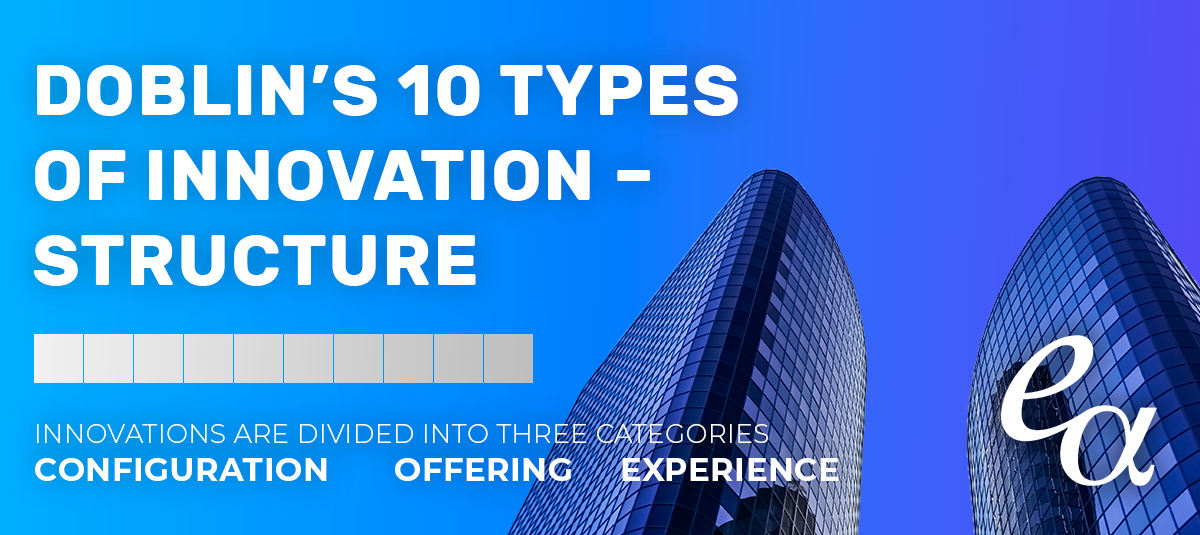Intro
In this series of posts, we will be inspecting Doblin’s 10 Types of Innovation, a popular framework for analyzing innovations in business developed by the Doblin Innovation Firm in Chicago. Innovations are divided into three categories: configuration, offering, and experience. Configuration focuses on the innermost workings of an enterprise and its business system, offering focuses on an enterprise’s core product or service, and experience focuses on customer-facing elements. In this post, we will analyze the third block in configuration, structure innovation.
Definition
Structure Innovation is essentially about how you organize and align your assets and talents. Doblin defines structure innovation as:
“Structure innovations are focused on organizing company assets—hard, human, or intangible—in unique ways that create value. They can include everything from superior talent management systems to ingenious configurations of heavy capital equipment. An enterprise’s fixed costs and corporate functions can also be improved through Structure innovations, including departments such as Human Resources, R&D, and IT. Ideally, such innovations also help attract talent to the organization by creating supremely productive working environments or fostering a level of performance that competitors can’t match.”
Structure innovations are great competitive advantages since they can be exceptionally difficult for competitors to copy, as they usually require major organizational change, large capital investments, and support from company leaders. However, it’s important not to confuse structure innovations for process innovations. Though closely related, structure innovations refer to the nature of a company’s talent and assets and how they are organized, while process innovations refer to how assets are used in practice.
Examples
There are various examples of structure innovations that include:
- Incentive systems – to encourage employees to work towards certain goals
- Standardizing assets – to reduce operating costs and complexity
- Corporate universities – to provide sophisticated, continuous, and large-scale training for employees with a dedicated space
- Competency centers – to have specialized hubs of people and resources that specialize in a given skill or area
- Knowledge management – to catalog information and insights for internal use for all business units
- Outsourcing – to use external firms to handle tasks and projects
For this blog post, we will focus on structure innovations surrounding hard assets and human assets.
Hard Assets
These structure innovations have to do with how companies structure or manage their hard assets and fixed costs.
Apple
Apple is an American multinational technology company that designs, develops, and sells consumer electronics, computer software, and online services. Apple outsources much of their manufacturing to third party suppliers like Foxconn, a move that drastically reduces the price of their goods. While Apple is far from unique in their outsourcing of manufacturing, it is a perfect example of how outsourcing reduces fixed assets and allows companies to offload balance sheet strain.
GE’s Crotonville Management Development Institute
General Electric is an American multinational conglomerate that operates in multiple industries, including aviation, healthcare, renewable energy, and manufacturing. Their Crotonville Management Development Institute, established in 1956, claims to be the oldest corporate university in the country, providing facilities and a training ground for high-quality managers — one early student, Reginald Jones, went on to become the GE CEO. While manager training would usually be associated with developing human assets, the idea of dedicated hard assets for manager training was a structure innovation.
McDonald’s
McDonald’s is an American fast food company founded in 1940 with tens of thousands of restaurants throughout the world. Unlike many fast food companies who simply franchise, McDonald’s makes far more money by going one step further — they own much of the land under their restaurants and lease it back to franchisees. This ownership of real estate allows for greater profits as well as favorable tax situations due to laws that are advantageous for real estate owners, like depreciation.
Sky Urban Solutions
Sky Urban Solutions is a Singapore-based company that specializes in vertical farming. Because Singapore is a small island with scarce natural resources and land for farming, Sky Urban Solutions began developing vertical farming for the urbanized country as a way of maximizing space and plant growth. The concept of vertical farming changed the way people traditionally thought about hard assets like land in relation to agriculture.
Human Assets
These structure innovations have to do with how companies utilize their employees and management systems.
Google is an American multinational technology company that specializes in Internet-related services and products. Their 20% Project allows employees to spend 20% of their time working on personal projects that could be beneficial to the company. These types of initiatives are widespread in Silicon Valley, and many argue that they lead to more productive and satisfied employees.
Alibaba
Alibaba is a Chinese multinational technology company specializing in e-commerce, retail, Internet, and technology. While people traditionally think of outsourcing as work that American companies offload to Chinese companies due to cheaper labor, Alibaba did the opposite by hiring remote workers in the U.S. to develop their website. As a result, Alibaba took off and became one of the largest e-commerce companies in the world and proved that outsourcing to obtain highly trained workers was economically feasible.
Whole Foods is an American multinational supermarket chain that has an emphasis on natural and organic products. Characterized as a “high trust organization,” decentralization and transparency are two core aspects of their management philosophy — each department within any store is given the responsibility of making many of their own decisions. Because data like sales, profitability, performance, and even salaries and bonuses is available to every employee, employees strive to outperform each other as departments compete for profitability.
Zappos is an American online shoe and clothing retailer that was acquired by Amazon in 2009. In 2013, CEO Tony Hsieh radically reorganized the company into a holacracy, a decentralized management system that boasted “no job titles, no managers, no hierarchy” where teams operate like small independent businesses, even operating their own individual budgets. While a holacracy represents one side of an extreme, there are an infinite number of management structures that exist between strict hierarchies and holacracies that can be adapted to fit businesses.
L. Gore is an American multinational manufacturing company specializing in products derived from fluoropolymers, best-known as the developers of Gore-Tex fabrics. W.L. Gore follows a “flat lattice” organization model, where teams are intentionally kept small and are driven by commitments rather than orders from management. In addition, all employees become shareholders after one year of working at the company, further motivating them to contribute to the company’s success.
OneLeap is a UK-based innovation consultancy founded in 2009. OneLeap sets up a semi-autonomous unit of entrepreneurs inside their client’s company for a period of six weeks, coordinating the engagement between the entrepreneurs and internal management. This unique arrangement helps clients innovate without draining their resources and increasing efficiency, as clients can continue operating while allowing the entrepreneurs to innovate on their behalf.
Techniques to Develop Structure Innovation
To innovate structure, a company must inspect the tasks and processes that make up the base of the organization. From IT to payroll to hard assets like buildings and land, a company has to challenge its baseline assumptions of what’s necessary and where there’s opportunity for innovation. Can new technology be invested in? Can tasks be outsourced? Can hard assets be thought of and utilized in a different way?
The most common structure innovation revolves around human assets and management structure. Every company has different needs from both managers and employees, and thus, many companies can benefit from adopting one of the various organizational structures that exist, from traditional hierarchical structures to more experimental ones like holacracies. Smaller companies especially gravitate towards flatter structures, though they may find that it is unsustainable as they scale up. At the same time, reinventing the wheel isn’t always necessary. Sometimes, innovation is as simple as creating a new department dedicated to specific tasks, like research and analytics.
Ultimately, a company must find the management structure that’s best for its managers and employees. One could start by asking employees how they work best and get a sense of how individuals and teams work. Sometimes, an overall consensus may not be enough. Humans are creatures of habit, and some may prefer to stay within a certain structure simply because that’s what they already know. However, it’s important to note that shaking things up won’t necessarily lead to increased productivity. Leadership must make a judgement call based on as much information as they can gather.
Through it all, the most important element in structure innovation are great people. The best management structure in the world means nothing if the people involved aren’t able to take full advantage of it. In this day and age, finding and retaining the best workers is crucial to the success of a company’s structure. In fact, the right structure, with the right people, can lead to seemingly limitless continuous innovation and growth for a company.
Impact
Although sometimes difficult to plan and execute, structure innovations, when done right, can make workplaces more efficient and employees more satisfied. Ideally, such innovations can help attract talent to the organization by creating supremely productive working environments or fostering a level of performance that competitors can’t match. Structure innovations that challenge organizational structure can improve the quality of life for employees who dislike traditional, rigid structure and give them the flexibility they need to be most productive. Over time, the more variety in organizational structure across industries and companies, the more society’s expectations of workplaces will shift and thus become more accommodating of employees who work better under non-traditional settings.
Though structure innovation in the sense of hard assets can be especially difficult, if one thinks sufficiently outside of the box, there can be far-reaching implications. For instance, the idea to focus on real estate at McDonald’s is fundamentally not what their original business strategy was, but it’s been so profitable for them that some even go so far as to say that McDonald’s is more in the real estate business than it is in the fast food business. Overall, structure innovations can have long-reaching effects on people’s understanding of businesses and how they operate.
Conclusion
Structure innovation can take many forms, but at their core, they have one characteristic in common: commitment. Behind every great structure innovation was a company that was willing to differentiate itself and take a risk. The rewards for taking such a risk include increased efficiency, stronger financials, and satisfied employees who are more motivated, which usually lead to a “wide moat” — a seemingly insurmountable separation between a company and its competitors. The very best structure innovations are in and of themselves difficult for competitors to replicate and can fundamentally redefine what’s possible for a company within an industry.




